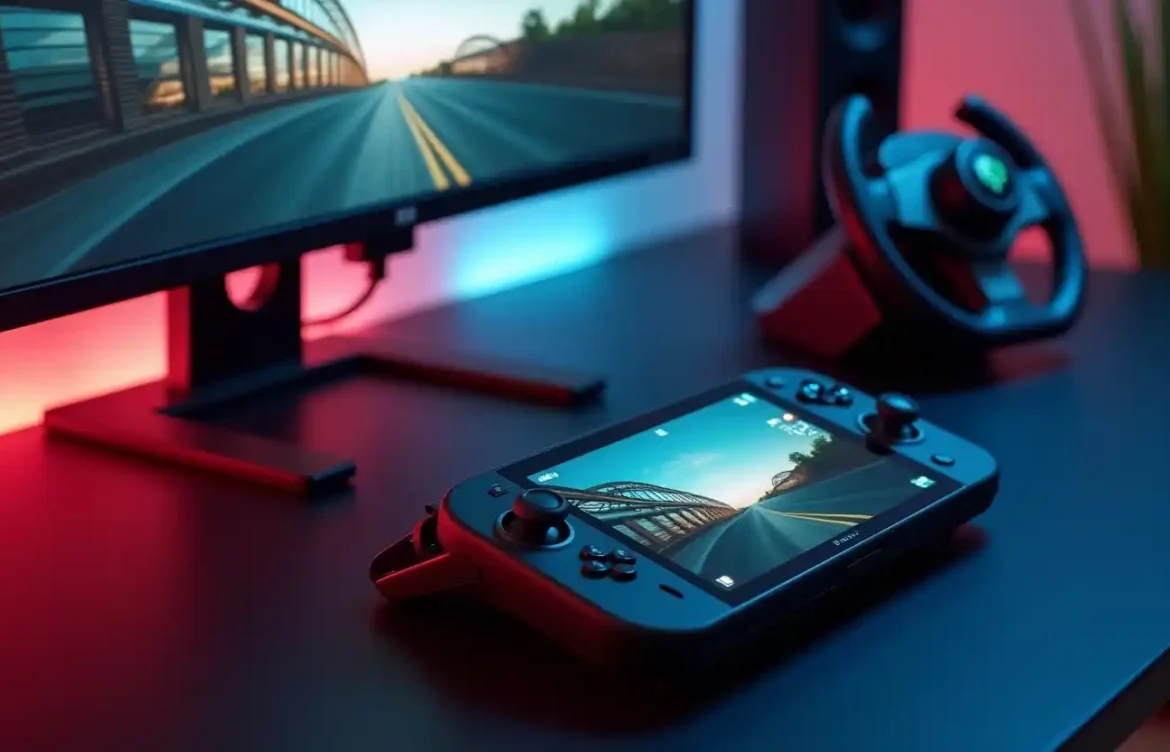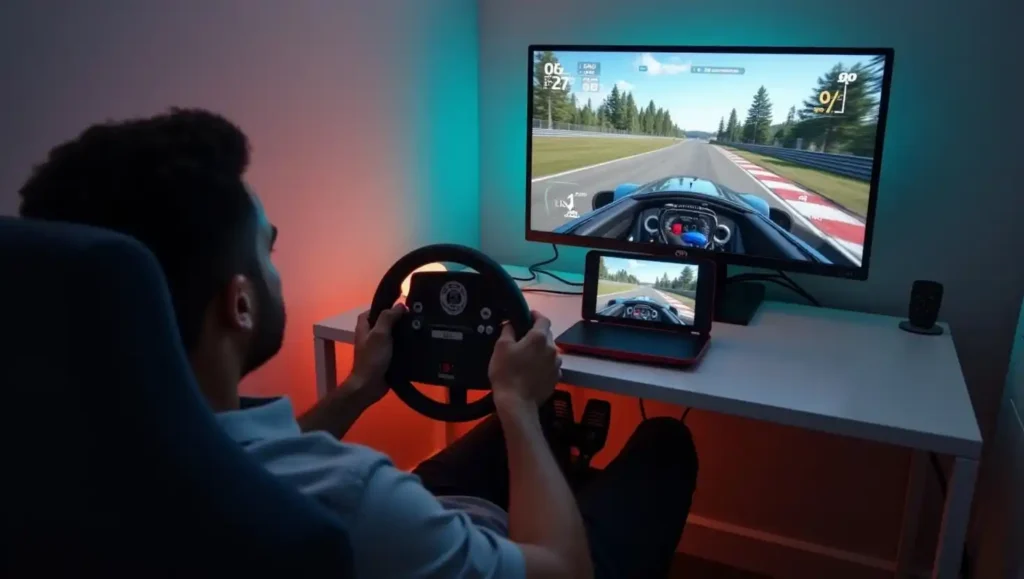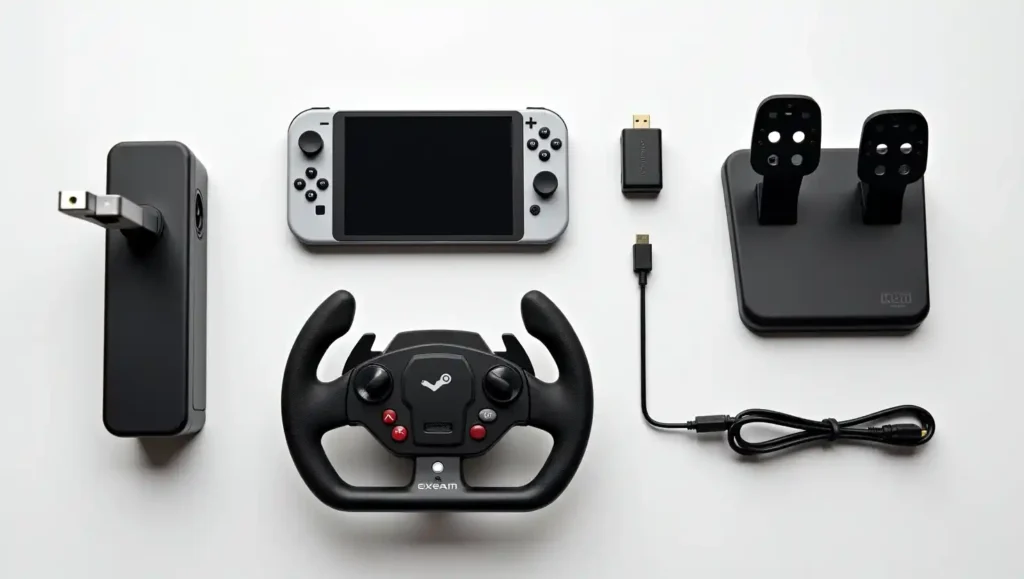
Sim Racing on Steam Deck: Is It Worth It?
Sim racing on Steam Deck might become popular in the near future. The Steam Deck runs most racing games smoothly, from F1 2023 to Assetto Corsa Competizione. You can play anywhere, anytime, without being stuck at a desk with a big PC setup.
But the small screen means you miss details you’d see on a monitor. The built-in controls work, but they’re not like a real racing wheel. Some games need tweaking to run well.
Though, the portability makes up for what you lose in graphics. You can practice your racing skills on the couch, during breaks, or while traveling. Plus, the Steam Deck handles most racing games better than you’d expect from a handheld device.
Gaming Tech Series will cover what you need to know about sim racing on Steam Deck. This includes performance, hardware compatibility, game library, setup steps, and real user experiences. By the end, you’ll know if the Steam Deck is right for your racing needs.
Can You Sim Race on Steam Deck?
Yes, you can play almost any game on Steam Deck. Steam Deck can easily run sim racing games like F1 23, Forza Horizon, and Assetto Corsa EVO and with decent & playable performance on the device.
But let’s be real here. You won’t get the same smooth 144fps experience you’d get on a gaming PC or a console. Some tracks might drop to 40fps during busy moments. The 7-inch screen feels cramped when you’re trying to spot brake markers or read timing displays.

And don’t expect to win any online championships using just the Steam Deck’s built-in controls. It’s more like having a decent backup racing setup that fits in your backpack.
How Does Sim Racing Games Perform on Steam Deck
Sim racing on Steam Deck delivers solid performance for a handheld device. In native handheld mode, you’ll get 30-60 fps on low to medium settings at 800p resolution. This might sound low, but it feels smooth enough for racing.
Docked mode changes everything. Connect your Steam Deck to an external monitor and you can push 1080p at 60+ fps. The extra screen space makes a huge difference for spotting racing lines and reading lap times.

Recent updates show the Steam Deck handling more demanding sims. Tokyo Xtreme Racer runs at a stable 60 fps, which surprised many players. The key is finding the right settings balance between visual quality and smooth gameplay.
Performance Benchmarks for Sim Racing on Steam Deck
F1 23: 45-60 fps (medium settings)
Forza Horizon 5: 40-55 fps (medium settings)
Assetto Corsa Competizione: 35-50 fps (low-medium settings)
Dirt Rally 2.0: 50-60 fps (medium settings)
Tokyo Xtreme Racer: 60 fps (medium settings)
Gran Turismo 7 (via emulation): 30-40 fps
Automobilista 2: 45-55 fps (medium settings)
What You Need to Setup Sim Racing on Steam Deck
Hardware:

If you want to make sure that your f1 racing simulator setup works on Steam Deck, you should know it starts with the right gear. Here is what you’ll need;
- Steam Deck Dock or any USB-C hub with enough ports.
- Popular wheels like Logitech G923, or Thrustmaster T150 as they work immaculously.
- Good pedals, they usually come with the wheel but if you want to only get pedals and try gyro steering using the Steam Deck’s built-in motion controls – just tilt the device to steer.
Note: Button mapping lets you customize controls exactly how you want. Make sure your hub has power delivery to keep your Steam Deck charged during long racing sessions. Some wheels need extra power, so check if your hub can handle it.
Software Setup:
F1 racing simulator setup software takes a few steps only. Begin with switching to Desktop Mode by holding the power button and selecting it from the menu. Most racing wheels need Proton (Steam’s Windows compatibility layer) or native Linux drivers to work properly.

Install wheel configuration tools such as Steam Input for basic setup, Oversteer for advanced wheel settings, or ProtonFS for file system tweaks. Each racing game works best with specific Proton versions – newer games usually need Proton Experimental.
Test your wheel in Steam’s controller settings first to make sure force feedback and all buttons respond correctly before launching games. And voila you are ready!
Best Sim Racing Games on Steam Deck
F1 23 runs amazing on Steam Deck and gives you that authentic f1 racing simulator setup experience with real teams and drivers. Forza Horizon 5 offers incredible graphics and smooth gameplay, perfect for casual racing fun. Assetto Corsa EVO brings hardcore simulation with tons of car and track mods available.
Performance varies by game – F1 23 hits solid 60fps at medium settings, while Forza Horizon needs some tweaks for smooth play. Most games run best at 800p resolution with medium presets and 30-60fps frame caps. Turn off ray tracing and reduce shadow quality first if you need more performance.
Pros & Cons of Sim Racing on Steam Deck
| Category | Steam Deck Pros | Steam Deck Cons |
| Portability | Race anywhere – couch, travel, breaks | Smaller screen, awkward wheel position in handheld |
| Accessibility | No PC required, instant grab-and-play | Setup complexity (drivers, docking) |
| Performance | Decent fps on many sims at medium settings | Heavier sim racing games need GPU power; battery runs out fast |
| Flexibility | Use gyro or wheel; works docked on monitor | Not officially validated for wheels/FFB |
How to Set Up Sim Racing on Steam Deck
- Connect deck to dock or USB hub
- Plug in USB wheel + pedals
- Launch game in Desktop Mode
- Configure Proton version (e.g., Proton 9+)
- Customize controls—enable gyro or wheel mapping
- Tweak graphics to balance fps and visuals
- Enjoy racing on handheld or monitor
- Optimize settings and save as custom profile
Are You Planning to Purchase Steam Deck for Sim Racing?
Sim racing on Steam Deck is impressive in terms of being a portable racing mode for casual sessions. Your f1 racing simulator setup becomes truly mobile – imagine practicing Monaco corners during lunch breaks or racing friends online from anywhere with WiFi.
It handles casual to beginner to mid-tier racing sims really well, giving you smooth gameplay and decent graphics. However, serious sim racers should stick with gaming PCs or consoles for now. Steam Deck shines when you want flexibility and portability over pure performance.
Try different games, experiment with settings, and join Steam Deck racing communities to share your setup tips. The device keeps getting better with software updates, making it an exciting time to jump into portable sim racing.
If you’re still deciding between platforms, check out our detailed comparison: [PC vs Console for Racing Simulator in 2025: Pros and Cons Explained] to help make the best choice for your racing needs.
FAQs in Sim Racing on Steam Deck
- Can I use a steering wheel with Steam Deck?
Yes, you can use a steering wheel with the Steam Deck. Most USB racing wheels are compatible when docked or connected via a USB-C hub. You’ll need to enable desktop mode and configure the wheel using Steam Input or third-party tools like Oversteer. Basic steering and pedal input generally work well. - Does gyro steering have latency?
Gyro steering on the Steam Deck has minimal latency when properly configured. Steam Input allows users to create or download custom gyro profiles for racing games. When fine-tuned, the gyro offers a surprisingly responsive and immersive control method. For best results, keep frame rates above 40 fps and adjust sensitivity in-game. - Is Force Feedback supported?
Yes, but Force Feedback support on Steam Deck varies by wheel and game. Many wheels work with basic force input, but full FFB may require additional driver layers through Proton or Linux tools. Expect some limitations compared to full PC setups. - Can I dock it to a monitor and race like on PC?
Yes, you can dock your Steam Deck to a monitor and race like on a PC. With the official Steam Deck Dock or a compatible USB-C hub, you can connect an external display, a racing wheel, and peripherals. The Deck supports 1080p output, making it easy to run your favorite racing sims on a monitor or TV using desktop mode. This setup allows you to build a compact, portable racing rig with near-PC functionality.
